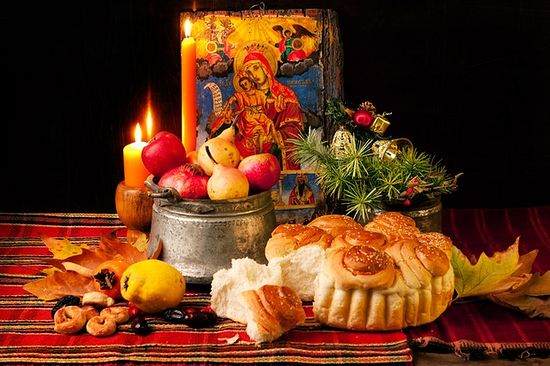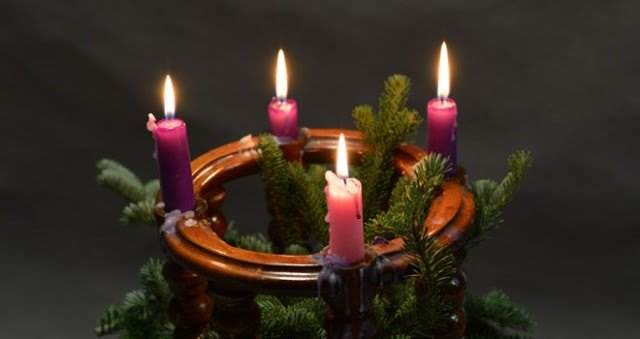Christians celebrate advent every December and the period covers the four Sundays prior to Christmas Day itself.
Advent is when churchgoers and Christians tend to think about the real meaning of Christmas instead of modern-day distractions.
The word Advent itself is the Latin for Coming and refers to the four weeks coming up to the anniversary of Christ’s birth.
Advent is not just referring to the coming of Jesus as a baby some 2,000 years ago in Bethlehem.
Many Christians also take Advent to mean that Christ is coming into our lives here and now.
Yet another coming that Advent could be pointing towards is some unknown date in the future when Jesus will return to act as a judge and also the king on Judgement Day.
The first Sunday in Advent will be between 27 November (as it was in 2016) and 3 December (in 2017).
Advent has been celebrated for many centuries, though nobody knows the exact date the tradition started from.
The earliest mention of Advent celebrations was in 567 when monks were ordered by the church to fast in the four months before Christmas.
There are differences in how Advent is observed among the different Christian denominations.
Some Christians decide to not eat anything (or fast) during Advent to help themselves get ready for the coming of Jesus.
Advent lasts for longer in the Orthodox and Eastern Catholic churches, as it for 40 days instead of four weeks.
It begins on 15 November and is also known as the Nativity Fast, the Celtic Church also started Advent from the same date.

In the Orthodox Churches, worshippers do not eat meat or consume dairy products for the whole of Advent.
On some days people will not eat fish, drink wine or use oil. The Greek Orthodox Church prepares calendars to show what can be eaten or drunk each day during Advent.
In England, during pre-Medieval and Medieval times, there was an early version of Nativity plays known as the vessel cup or Advent images.
Two dolls of Mary and the baby Jesus were put in a box and taking round villages.
People thought it was unlucky if they did not see at least one Advent before Christmas Eve. People used to pay half a penny to see into the box.
Some of the best known Christmas carols were actually written as Advent carols.
These favorites include people, look East, O Come O Come Emmannuel, and Lo! He comes with clouds descending.
Tradition also includes being able to count down the days with candles and calendars.
Advent Calendars
There are various Advent calendars available, with the most common types in the United States and Britain being made of card or paper and featuring 24 or 25 small windows.
Every single day in December a window is opened until the last picture is revealed on Christmas Day itself. Some calendars end on Christmas Eve and the rest run till Christmas morning.
The origins of the Advent Calendar can be traced back to the Protestant areas of Germany during the 19th century.
On 1 December 24 chalk lines were drawn on doors and a line was scrubbed out each day until Christmas.
The Germans were also responsible for making cardboard and paper calendars poplar from the early tears of the 20th century.
Before then people had been making their own since the 1850s.
Nobody knows the exact date when these calendars were first mass-produced, yet it would almost certainly have been in Germany before the First World War.
During the Second World War, calendars were not made as there was not enough paper or card.

Originally, the calendars would depict Christmas themes or wintery scenes. However, as Christmas became more about marketing many calendars depict TV shows, celebrities, toys, and even sports teams.
The most popular have chocolates behind each day (which, I loved as a kid), and some must be brought by adults for themselves.
Though chocolate-filled calendars have been sold since 1958 these became really popular from the 1980s.
Some calendars are not made from paper. For instance, in Germany fir wreaths contain 24 little cloth bags, with miniature presents inside.
- In 2007 the world’s biggest Advent Calendar to date was at St Pancras Train Station in London. The calendar was 71 m in height and 23 m in width. It was made to mark the reopening of the station after a refit.
- Belgium in 2010 was were the most expensive calendar was made by jewelers. It contained diamonds and silver worth $ 3.3 million (a staggering 2.5 million euros or £2.5 million.
Advent and Candles
There are two different ways that candles are used in Advent to mark the run into Christmas.
The first way is to have a long candle and mark out 24 lines, all an equal distance from each other.
Each evening the candle is burnt from one line to the next. The final part of the candle is lit and used up on Christmas.

A different take of lighting 24 little candles in each church was done from the 1700s in the Lutheran Churches of Scandinavia.
The other main way of using Advent is to have five candles. On the first Sunday in advent a single candle is lit, the second week two are lit, until Christmas Day when all five are lit.
Although each denomination attaches different meanings to each candle the following is how it was taught where our family attended church services:
- The first candle represents the Old Testament prophets that predicted the coming of Jesus, especially Isaiah.
- The second candle is the Holy Bible
- The third candle represents Mary, the mother of Jesus.
- The fourth candle is for John the Baptist, who prepared the world for the coming of Jesus.
- The final candle is for Jesus himself. The candle is symbolic of Jesus being the light of the world.
Learn More With the Help of Video
Main Points About Tradition of Advent
- Advent is a time of expectations, patiently waiting and preparing for the celebration of the nativity of Jesus and his second coming.
- The word Advent means mean arrival or coming. It has its root in the Latin word ‘adventus’.
- During the advent, some people fast in preparation. Advent is seen from three different perspectives: The nativity, the acceptance of Christ and the actual second coming.
- One of the traditions associated with advent includes praying a daily advent devotional. During Advent, many Christians attend church services to pray together.
- Other advent traditions include keeping an advent calendar, putting up a Christmas tree, lighting an advent wreath, lighting a Christingle, putting up Christmas decorations and preparing for Christmas.
Conclusion
Advent is the four Sundays before Christmas, although it starts earlier in some Orthodox countries.
Advent is Latin, meaning ”coming” and not ”waiting” as many people believe.
It’s now the time for Jesus coming into the world which is referred to and Christians prepare for and remember the meaning of Christmas during this time, lighting a candle every Sunday.
This is also when the liturgical year of the Church starts.
Word Cloud for Tradition of Advent
The following is a collection of the most used terms in this article on the Tradition of Advent. This should help in recalling related terms as used in this article at a later stage for you.

- https://www.christianity.com/christian-life/christmas/what-is-advent.html
- https://en.wikipedia.org/wiki/Advent
- https://www.infoplease.com/calendar-holidays/major-holidays/advent-dates-traditions-and-history

I’m so happy to see an article discussing this topic. I think it’s important to keep these traditions alive.
I’m glad to see others passionate about this topic. It’s quite underappreciated.
I couldn’t agree more. It’s a wonderful way to celebrate the true spirit of Christmas.
This is a great article, I learned a lot about the history of Advent that I didn’t know. Thank you for sharing!
I also found this to be very eye-opening. How interesting!
I agree, I didn’t know half of this information. It’s great to learn something new.
This was a wonderfully thorough overview. I appreciate the level of detail provided here.
The level of detail was indeed impressive. A well-researched piece.
It’s not we see such comprehensive articles. I found it quite enlightening.
While I appreciate the thoroughness of this article, I found it to be quite dry and not engaging.
I understand your perspective, though I think it’s important to have articles like this that offer a deep dive into historical traditions.
I actually found this to be incredibly engaging, and I’m not interested in religious history.
Advent is a beautiful tradition with deep historical roots. This was a captivating read.
I couldn’t agree more. The history of Advent is truly captivating.
Another religious article trying to push its agenda. Can’t we have more neutral information?
I understand where you’re coming from, but I don’t think there’s any harm in sharing this informative piece.
I found the historical recounting of Advent to be truly fascinating. What a wonderfully rich tradition.
I particularly enjoyed the rich historical context this article provided.
Agreed. It’s quite fascinating to delve into the roots of such enduring traditions.
I found this article to be quite repetitive, simply listing facts about Advent.
Actually, I think the repetition helps drive the point home for those who may be new to the topic.
I agree, it would have been nice to see a bit more detail on how these traditions came about.
I appreciated this article, although I wish there was a bit more intrigue in the storytelling.
I can understand that, but I’m glad to see the information presented in a clear and factual manner.
An interesting read, but I can’t help but feel that some of the information is unnecessary in today’s world.
Given the resurgence of interest in traditional practices, I think the information is quite pertinent.